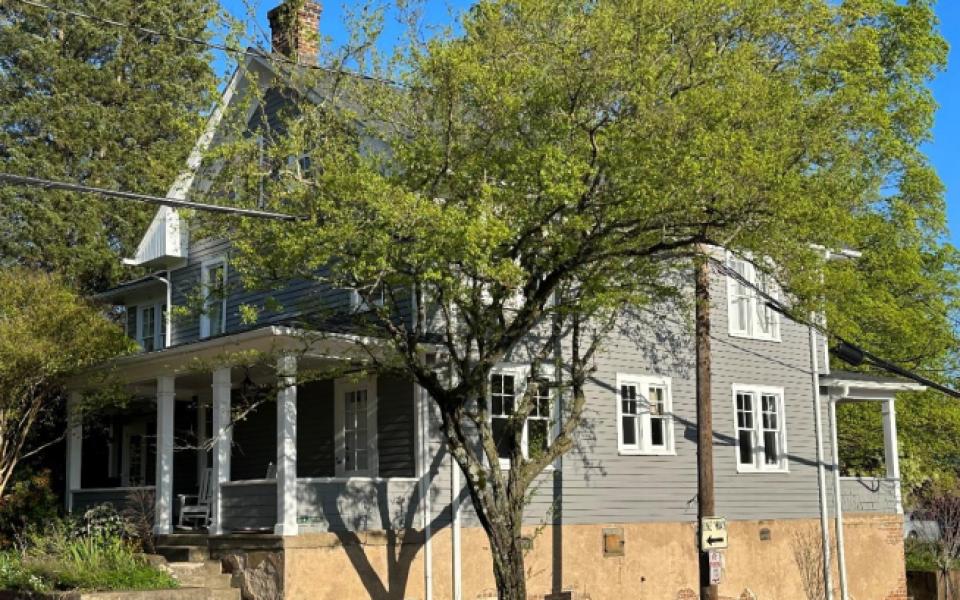Featured photo: Exterior of Peter Fetter house (photo by Howard Kelly)
The Peter Fetter house has stood in Old Salem for nearly two centuries. Brick chimneys perch above the home’s gray exterior and white trim; the yard boasts native cedar trees, dogwoods and flowers. A stone path tiptoes around the property. Located at 319 S. Main St. in the South Ward, a portion of this classic home is now recognized as a local historic landmark, per a city council decision on Jan. 8. The original landmark request was for the interior, exterior and site. The backyard is pressed up against the Salem Moravian Graveyard known as “God’s Acre.”
The Historic Resources Commission, or HRC, unanimously found that the house “did not hold special local significance” and recommended that Winston-Salem’s city council deny the request. Still, councilmembers voted 5-3 to grant landmark status to the home’s exterior and site. Councilmembers John Larson, Robert C. Clark and Jeff MacIntosh voted against the designation.
Just like the city, this nearly 200-year-old home has gone through some changes.
When it was built in 1840, the home had two rooms upstairs and two rooms downstairs. The kitchen was originally a workshop until Peter Fetter, a chairmaker, constructed a new shop in 1842 and used the old one as a kitchen, “since he lacks enough space in his house.”
In 1847, the home got even bigger when Fetter got married. The house expanded, now containing four rooms upstairs and four downstairs.
In 1920, the house was purchased by Walter Hege and converted into a duplex, to meet the “contemporary needs of the growth of the city at the time,” the home’s owner James Howard Kelly told councilmembers on Monday. The construction put a wall through the house, creating a kitchen for each side. Kelly’s application states, “While the Fetter House is important because of its long history in Salem, it is equally important as one of the most fully realized and intact examples of a 1920s duplex in Winston-Salem, a period characterized by broader urbanization and the growth of duplexes and multifamily housing in the city.”

Does change bury history?
The Peter Fetter house is “part of the fabric of Old Salem and it always will be,” Kelly told council on Monday.
Kelly argued that one of the reasons the home is significant is because it is one of the only remaining conversion duplexes from the 1920s left in Winston-Salem. However, the city’s Historic Preservation Officer Michelle McCullough stated in her staff report on the application that this argument “lacks substance and evidence.”
The mission of Old Salem Inc. and the local historic district is to “maintain and encourage restoration of the buildings to the 1766-1856 period of significance,” McCullough’s report continues, noting that the designation of this property, which has “not met that goal,” would “contradict the mission of both programs.”
The HRC found that the changes made to the home in 1920 “make the building lack special significance for its 1840 original construction and architecture.”
In 2017, the dividing wall in the kitchen was removed to create a larger kitchen space. McCullough said that the main reason the house was nominated — because it was a duplex — now no longer applied because the previously divided kitchens were “renovated into one space, making it one unit again.” However, Kelly addressed council to contradict McCullough’s statement, saying that the house still functions as a duplex and is used as one. The doors that separate the two sides of the home lock, much like a lockable hotel room door, he said.
“There are two separate heating bills, natural gas bills and electricity bills for each side of the house,” Kelly added.
The South Ward’s representative John Larson, Old Salem’s former vice president, acknowledged the significant threads that the house weaves into Winston-Salem’s fabric, but felt that the “core value of that house potentially to add to the historic district was buried underneath all of the changes that had occurred.”
“The fact that it’s a duplex doesn’t really add to the value of the house as a contributing structure to the Old Salem historic district,” he said.
Larson said that the historic district is defined “very clearly” by the “Moravian experience” and the 1766-1856 dates. He surmised that if the house were restored to its 1840 state, the HRC might look more favorably at it. However, “as it is, it does not contribute,” he said.
“I know that buried in there is still a good story, but not in its current condition,” he said.
Mayor Pro Tempore D.D. Adams spoke more sympathetically about the house’s historical status in the city.
“I just think it’s interesting that Old Salem and some other people, again, determine what’s historical and what’s not,” Adams quipped.
“It’s part of protocol, procedures, ordinance, zoning, I got it,” she acknowledged.
However, Adams reminded council of the iconic home’s prominent place in the community, pointing out that many who travel to Old Salem “see this house.”
All CityBeat reporting content is made possible by a grant from the NC Local News Lab Fund, available to republish for free by any news outlet who cares to use it. Learn More ↗
Republish this storyJoin the First Amendment Society, a membership that goes directly to funding TCB‘s newsroom.
We believe that reporting can save the world.
The TCB First Amendment Society recognizes the vital role of a free, unfettered press with a bundling of local experiences designed to build community, and unique engagements with our newsroom that will help you understand, and shape, local journalism’s critical role in uplifting the people in our cities.
All revenue goes directly into the newsroom as reporters’ salaries and freelance commissions.


Leave a Reply